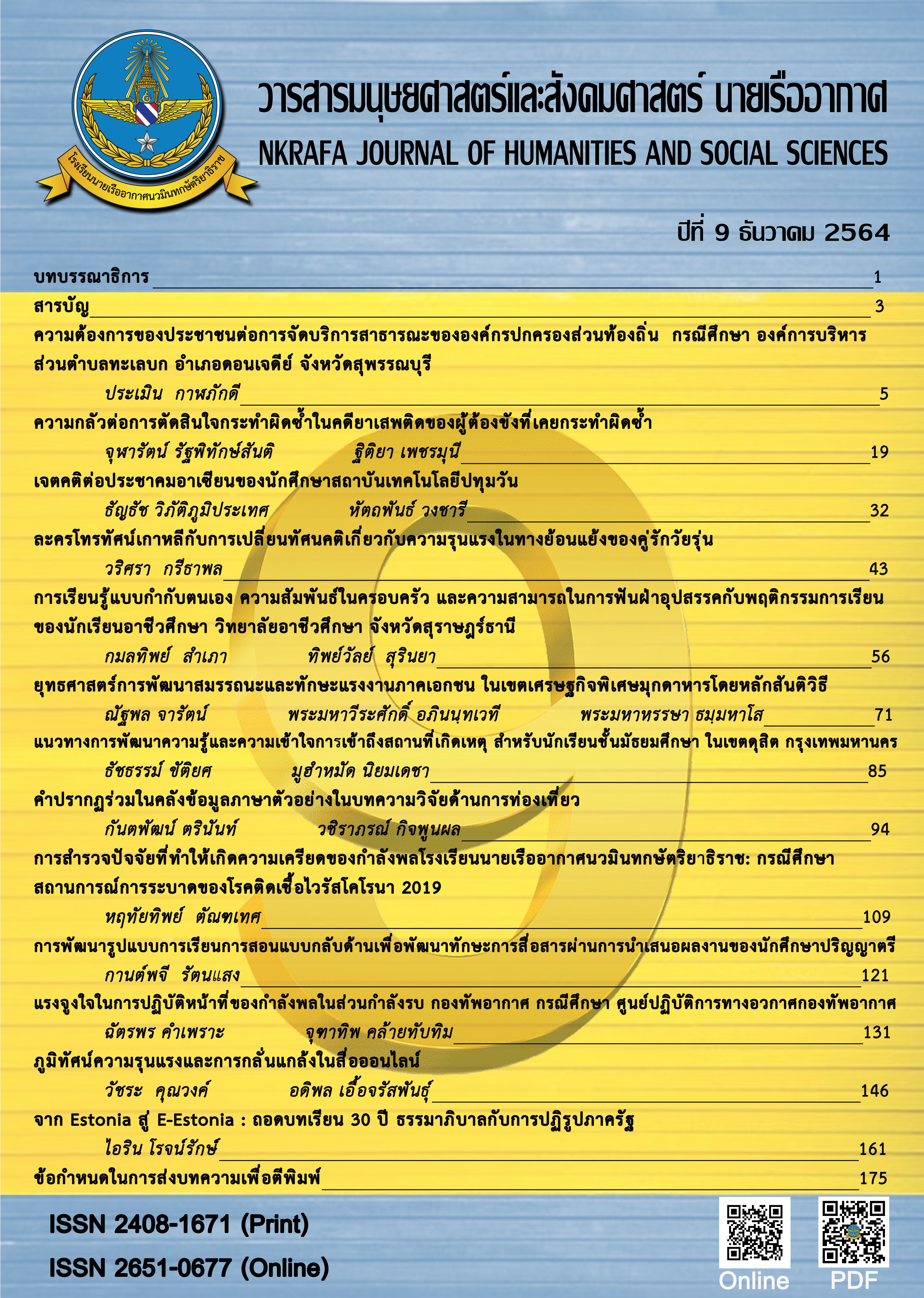Developing the Flipped Classroom Model for Improving English Communication Skill of Thai EFL undergraduates through the Presentation Mode
Main Article Content
Abstract
The purposes of this study were: 1) to develop the flipped classroom model for improving English communication skill of Thai EFL undergraduates through the presentation mode 2) to investigate the students’ opinion towards the flipped classroom model for improving English communication skill of Thai EFL undergraduates through the presentation mode. The sample group consisted of 25 students who enrolled in English for Professional Presentation course in the 2nd semester of the academic year 2019 from the Faculty of Food Industry. The purposive sampling was used to select the sample group. The present study covered 12 weeks with both outside and inside the classroom. The research instruments were video clips, activities at the end of each unit; five units in total, the activity at the end of the course, scoring rubrics, and the opinion questionnaire. The data were collected by using the effectiveness (E1/E2), Mean, and S.D. The results of this study revealed that the effectiveness of the flipped classroom model for improving English communication skill of Thai EFL undergraduates through the presentation mode was 82.7/80.2, which are higher than the defined criteria at 80/80. The students’ opinions toward the flipped classroom model for improving English communication skill of Thai EFL undergraduates through the presentation mode was 4.50, which means that students had a high level of satisfaction.
Article Details
บทความที่ได้รับการตีพิมพ์เป็นลิขสิทธิ์ของวารสารมนุษยศาสตร์และสังคมศาสตร์ นายเรืออากาศ
ข้อความที่ปรากฎในบทความแต่ละเรื่องในวารสารวิชาการเล่มนี้ เป็นความคิดเห็นส่วนตัวของผู้เขียนแต่ละท่าน ไม่เกี่ยวข้องกับโรงเรียนนายเรืออากาศฯ และคณาจารย์ท่านอื่น ๆในโรงเรียนนายเรืออากาศฯ แต่อย่างใด ความรับผิดชอบขององค์ประกอบทั้งหมดของบทความแต่ละเรื่องเป็นของผู้เขียนแต่ละท่าน หากมีความผิดพลาดใด ๆ ผู้เขียนแต่ละท่านจะรับผิดชอบบทความของตนเองแต่เพียงผู้เดียว
References
Li, V, “Social Media in English Language Teaching and Learning,” International Journal of Learning and Teaching, Vol. 3 (1), p 148-153, 2017.
Hashim, H, “Application of Technology in the Digital Era Education,” International Journal of Research in Counseling and Education, Vol.1(2), p 1, 2018.
Roehl, A., Reddy, S. L., & Shannon, G. J, “The flipped classroom: An opportunity to engage millennial students through active learning strategies,” Journal of Family &Consumer Sciences, Vol. 105(2), 2013.
American Council for the Teaching of Foreign Languages, “ACTFL Proficiency Guidelines,” [Online]. Available:https://www.actfl.org/publications/guidelines-and-manuals/actfl-proficiency-guidelines- 2012/english/speaking. [Accessed: 7 ธันวาคม 2563].
Hamdan, N., McKnight, P., McKnight, K., & Arfstrom, K. M, : The flipped learning model A white paper based on the literature review titled “A Review of Flipped Learning.” Arlington, VA: Flipped Learning Network, Pearson Publishers, New York, 2013.
Flipped Learning Network (FLN), “The four pillars of F-L-I-P™,” [Online]. Available:https://www.researchgate.net/publication/336216285_Flipped_Learning_Approach_Engaging_21_st_Century_Learners_in_English_Classrooms. [Accessed: 12 มกราคม 2564].
Cockrum, T, Flipping your English class to reach all learners strategies and lesson plans, Routledge Publishers, New York, 2014.
Gerstein, J, “The flipped classroom: a full picture,” [Online]. Available: http://usergeneratededucation.wordpress.com/2011/06/13/the-flipped-classroom-model-afull-picture/ [Accessed: 12 มกราคม 2564].
ชัยยงค์ พรหมวงศ์, “การทดสอบประสิทธิภาพสื่อหรือชุดการสอน,” วารสารศิลปากรศึกษาศาสตร์วิจัย, ปีที่ 5, ฉบับที่ 1, หน้า 7-20, มกราคม-มิถุนายน, 2556.


